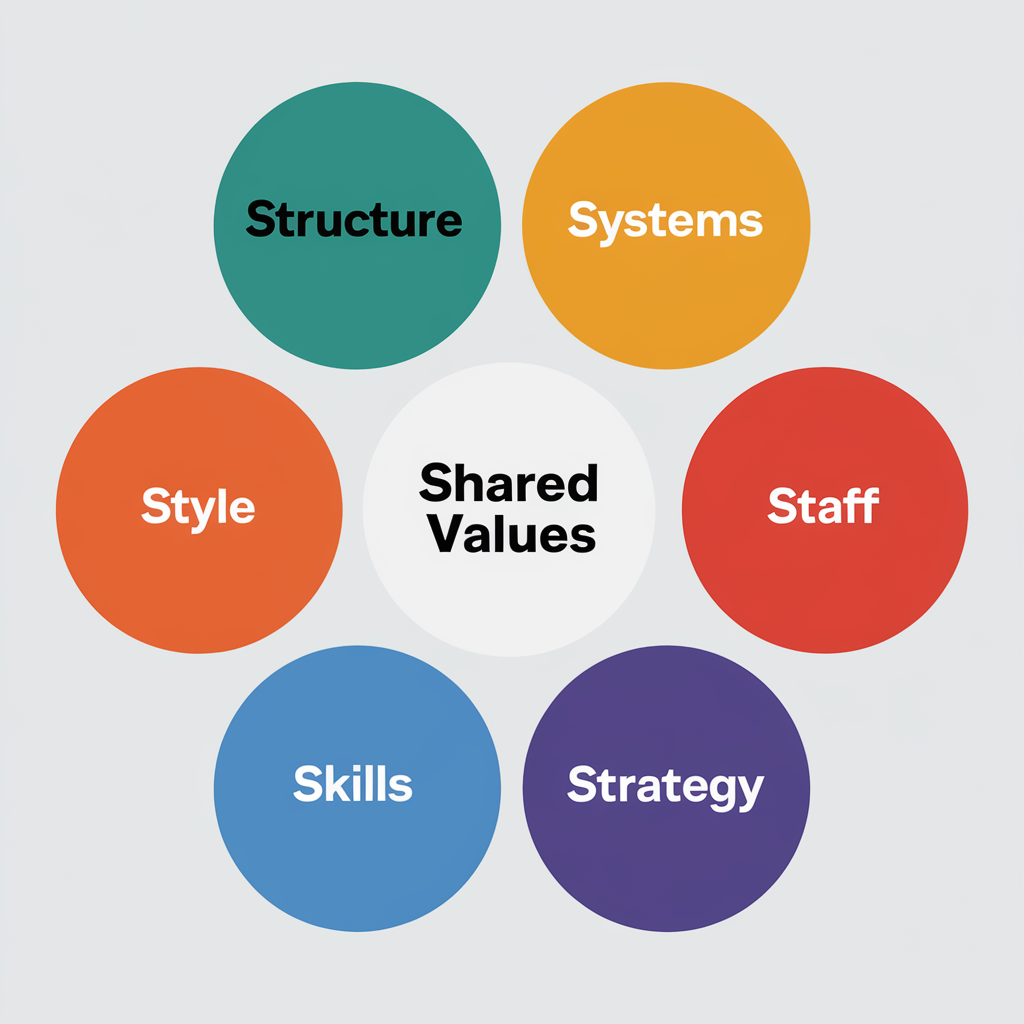Let’s rewind the clock to the late 1970s. The business world was evolving rapidly, and companies were struggling to keep up. That’s when Tom Peters and Robert Waterman Jr., two consultants at McKinsey & Company, stepped in. They were on a mission to understand what made the best-performing companies tick.
After studying successful organizations, they noticed a pattern. It wasn’t just strategy or structure that made these companies excel – it was a combination of seven interconnected factors. This revelation led to the birth of the McKinsey 7S Framework in 1980.
I remember when I first stumbled upon this framework early in my entrepreneurial journey. It was like finding a treasure map – I suddenly had a clear view of what made organizations thrive.
Interactive Case Study: McKinsey 7S Framework
Scenario: Revitalizing “Book Haven” Bookstore
“Book Haven”, a traditional bookstore, is facing challenges in the digital age. Online retailers and e-books have disrupted the market, and Book Haven is struggling to attract customers. You’ve been hired as a consultant to help them revitalize their business using the McKinsey 7S Framework.
What should be the primary strategic focus for Book Haven to compete in the changing market?
Conclusion
Congratulations! You’ve explored the key elements of the McKinsey 7S Framework in the context of revitalizing “Book Haven”. By considering the interplay of these elements, businesses can effectively navigate change and achieve their goals.
Unraveling the 7S Framework
The 7S Framework is built on seven elements, each starting with the letter 'S':
- Strategy
- Structure
- Systems
- Shared Values
- Style
- Staff
- Skills
These elements are divided into two categories: hard elements and soft elements. Let's break them down.

Hard Elements: The Tangible Trio
The hard elements are the more tangible, easily definable aspects of an organization:
Strategy: This is your game plan. It's how you intend to achieve your goals and gain a competitive edge.
Structure: Think of this as your organizational chart. It defines who reports to whom and how tasks are divided and coordinated.
Systems: These are the processes and procedures that characterize how important work is to be done.
These elements are typically easier to identify and manage. They're the bones of your organization - crucial, but not the whole story.
Soft Elements: The Human Touch
The soft elements are less tangible and more influenced by culture:
Shared Values: These are the core values of the company that are evidenced in the corporate culture and the general work ethic.
Style: This isn't about fashion - it's about leadership style and the way the company is managed.
Staff: This refers to the employees and their general capabilities.
Skills: These are the abilities and competencies of the employees working for the company.
These elements are harder to describe, less tangible, and more influenced by culture. They're the heart and soul of your organization.
The Interconnected Web: How the 7S's Work Together
Here's where the magic happens. The 7S Framework isn't just a list - it's a web of interconnected elements. Change one, and you affect them all.
| Element | Affects | Affected By |
|---|---|---|
| Strategy | Structure, Systems | Shared Values, Skills |
| Structure | Systems, Style | Strategy, Staff |
| Systems | Staff, Skills | Strategy, Structure |
| Shared Values | All other S's | All other S's |
| Style | Staff, Skills | Structure, Shared Values |
| Staff | Skills, Style | Systems, Structure |
| Skills | Systems, Style | Staff, Strategy |
This interconnectedness is what makes the 7S Framework so powerful. It forces us to think holistically about our organizations.
Practical Applications: Real-World Success Stories
I've seen the 7S Framework work wonders in various scenarios. Let me share a couple of examples:
Merger Integration: When two companies merge, it's not just about combining balance sheets. The 7S Framework helps identify areas of alignment and conflict across all seven elements, making the integration smoother.
Performance Improvement: A tech startup I mentored was struggling despite having a great product. Using the 7S Framework, we discovered that while their strategy and skills were strong, their systems and style were holding them back. Addressing these elements led to a 40% increase in productivity within six months.
Common Pitfalls and How to Avoid Them
While the 7S Framework is powerful, it's not foolproof. Here are some common pitfalls:
Focusing only on hard elements: It's tempting to focus on strategy, structure, and systems because they're easier to measure and change. But neglecting the soft elements can derail your efforts.
Ignoring interconnections: Remember, change in one element affects all others. Always consider the ripple effects.
Using it as a one-time fix: The 7S Framework isn't a one-and-done solution. It's a tool for ongoing analysis and adjustment.
To avoid these pitfalls, regularly revisit all seven elements, consider both direct and indirect impacts of changes, and make the framework a part of your ongoing management process.
Implementing the 7S Framework: A Step-by-Step Guide
Ready to put the 7S Framework into action? Here's a step-by-step guide:
- Identify the current state of each element
- Determine the ideal state for each element
- Compare current and ideal states to identify gaps
- Develop action plans to address gaps
- Implement changes
- Continuously monitor and adjust
Remember, this isn't a linear process. You'll need to revisit and refine as you go.
Measuring Success: KPIs for 7S Implementation
How do you know if your 7S implementation is successful? Here are some Key Performance Indicators (KPIs) to consider:
Strategy: Market share growth, revenue increase
Structure: Employee satisfaction, decision-making speed
Systems: Process efficiency, error rates
Shared Values: Employee engagement, cultural alignment
Style: Leadership effectiveness, employee trust
Staff: Retention rates, productivity
Skills: Competency assessments, innovation metrics
Track these KPIs before and after implementing changes to measure your progress.
The 7S Framework in the Digital Age
In today's digital world, the 7S Framework is more relevant than ever. Digital transformation affects all seven elements:
Strategy: Incorporating digital channels and business models
Structure: Flatter hierarchies, remote teams
Systems: Cloud-based tools, automation
Shared Values: Embracing innovation and agility
Style: Data-driven decision making
Staff: Digital literacy across all roles
Skills: Continuous learning, adaptability
The framework helps ensure that digital initiatives are holistic and aligned with the entire organization.
Criticisms and Limitations: A Balanced View
No framework is perfect, and the 7S model has its critics. Some argue that it doesn't explicitly consider external factors like market conditions or competition. Others say it's too complex for small businesses.
While these criticisms have merit, I've found that the framework's flexibility allows it to be adapted to various contexts. The key is to use it as a guide, not a rigid rulebook.
Alternative Models: How 7S Stacks Up
The 7S Framework isn't the only game in town. Other models like the Balanced Scorecard, PESTLE analysis, or the Galbraith Star Model offer different perspectives on organizational effectiveness.
However, what sets 7S apart is its emphasis on interconnectedness and the balance between hard and soft elements. It's not about choosing one model over another, but using the right tool for the job.
Future of the 7S Framework: Evolving with the Times
As we look to the future, the 7S Framework continues to evolve. Some experts suggest adding new S's like Sustainability or Stakeholders to reflect modern business priorities.
Personally, I believe the framework's strength lies in its simplicity and flexibility. Rather than adding elements, we should interpret the existing ones in light of new challenges and opportunities.
Conclusion: Harnessing the Power of 7S
The McKinsey 7S Framework isn't just a theoretical model - it's a practical tool that can transform your organization. By considering all seven elements and their interconnections, you can create a more aligned, effective, and resilient business.
Remember, it's not about perfecting each element in isolation. It's about creating harmony between them. Like a well-tuned orchestra, when all elements of your organization play in sync, the result is nothing short of magnificent.
So, are you ready to conduct your organizational symphony?
TL;DR
The McKinsey 7S Framework is a powerful tool for analyzing and improving organizational effectiveness.
It consists of seven interconnected elements: Strategy, Structure, Systems, Shared Values, Style, Staff, and Skills.
By considering all these elements and their relationships, businesses can create better alignment, improve performance, and navigate change more effectively.
While it has some limitations, its holistic approach and flexibility make it valuable in today's dynamic business environment.
Q&A
Q1: Who created the McKinsey 7S Framework?
A1: The McKinsey 7S Framework was developed by Tom Peters and Robert Waterman Jr., two consultants at McKinsey & Company, in the late 1970s.
Q2: What are the 7 S's in the framework?
A2: The 7 S's are Strategy, Structure, Systems, Shared Values, Style, Staff, and Skills.
Q3: How can the 7S Framework be used?
A3: The framework can be used for various purposes, including analyzing organizational effectiveness, guiding change management, aligning departments and processes, determining how to implement a proposed strategy, and examining the likely effects of future changes in the organization.
Q4: Is the 7S Framework only for large corporations?
A4: While it was initially developed with large corporations in mind, the 7S Framework can be adapted and used effectively by organizations of all sizes, including small businesses and non-profits.
Q5: How often should an organization use the 7S Framework?
A5: The 7S Framework is most effective when used as an ongoing management tool rather than a one-time analysis. Organizations should revisit the framework regularly, especially when planning major changes or facing significant challenges.
7S Framework Quiz:
- Does your organization have a clear, well-communicated strategy?
- Is your organizational structure aligned with your strategy?
- Are your systems and processes supporting your objectives efficiently?
- Do your shared values resonate with all levels of the organization?
- Does your leadership style foster the desired organizational culture?
- Is your staff adequately equipped to execute your strategy?
- Does your organization prioritize skill development aligned with its goals?
Scoring:
Yes = 1 point, No = 0 points
0-2 points: Your organization may benefit significantly from applying the 7S Framework. There's substantial room for improvement in aligning your organizational elements.
3-4 points: You're on the right track, but there's still work to be done. Focus on the areas where you answered 'No' to create better alignment.
5-6 points: Your organization is well-aligned in many areas. Fine-tune the remaining elements to achieve even better performance.
7 points: Congratulations! Your organization shows strong alignment across all 7S elements. Continue to monitor and adjust as your business evolves.
Remember, this quiz is a starting point. Use it to identify areas for deeper analysis and improvement using the 7S Framework.





